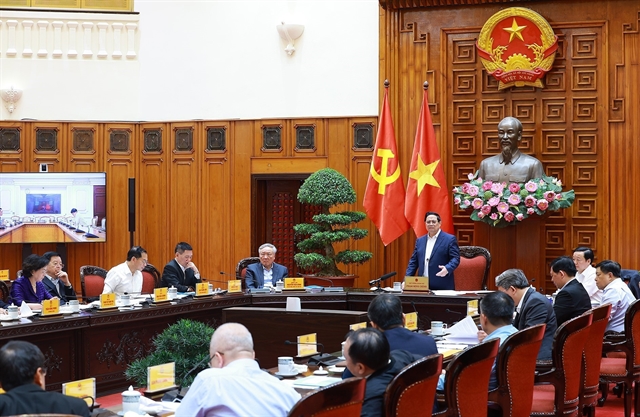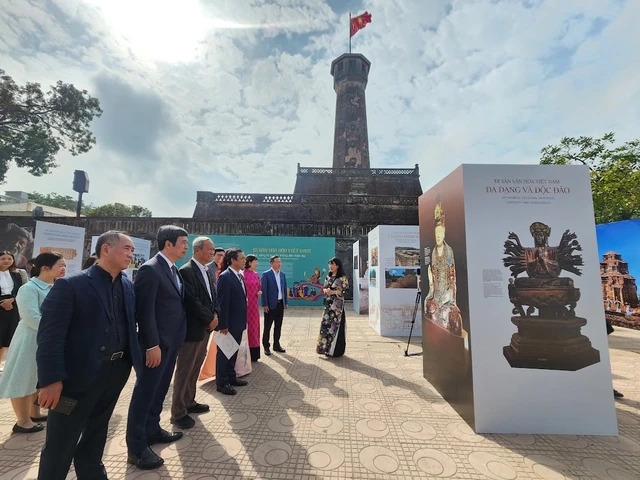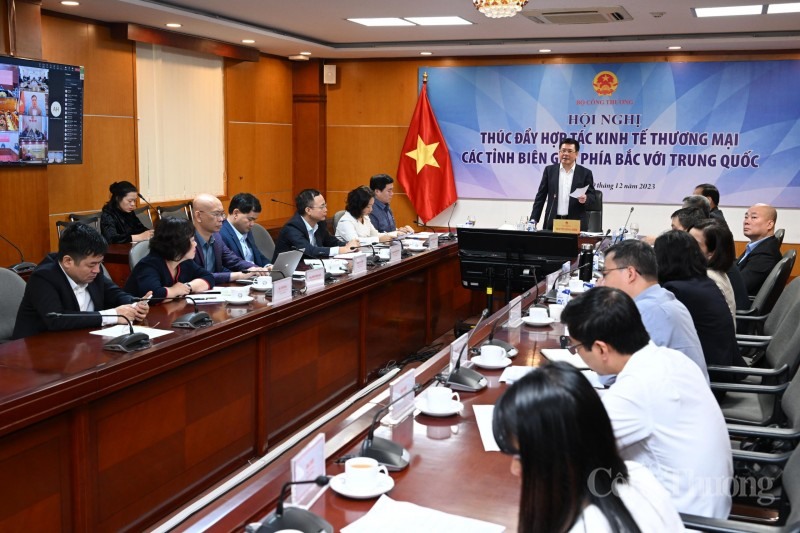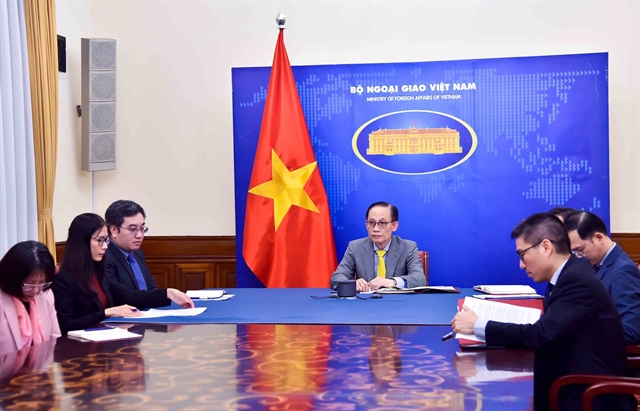 Economy
Economy

 |
| At the conference. Photo baocongthuong.vn |
HÀ NỘI — The collaborative ties between Việt Nam and China have unquestionably deepened yet persistent challenges in border trade, including underutilised infrastructure, limited quotas for essential exports, and technological constraints, call for strategic attention to foster a more flourishing partnership.
Minister of Industry and Trade Nguyễn Hồng Diên, while chairing a conference on December 9 on enhancing economic and trade cooperation of Việt Nam’s northern border provinces with China, said the strategic advantages of the nearly 400 km land border shared by China and Việt Nam offers unique opportunities for economic development, particularly in the trade economy of border areas and gates.
According to the trade ministry, this border connects seven provinces in Việt Nam— Điện Biên, Lai Châu, Lào Cai, Hà Giang, Cao Bằng, Lạng Sơn and Quảng Ninh, with Yunnan Province and Guangxi Zhuang Autonomous Region in the People's Republic of China.
In the economic and trade domain, Guangxi and Yunnan play significant roles as traditional markets. They are crucial not only for the seven northern border provinces but also for the overall economic and trade cooperation between Việt Nam and China.
For numerous years, China has held the position of Việt Nam's foremost trading partner. The comprehensive two-way trade turnover between Việt Nam and China constitutes a significant quarter of Việt Nam's total import-export turnover globally, Minister Diên said.
Conversely, Việt Nam ranks as China's 6th largest trading partner globally, standing out as China's leading partner within the ASEAN region.
Diên also said following General Secretary Nguyễn Phú Trọng's visit to China at the end of 2022, there have been substantial shifts in the political and diplomatic relations between the two nations. Economic and commercial activities, particularly border trade, have experienced a revitalisation. Numerous border gates have returned to operating conditions seen before the COVID-19 pandemic.
A report by the Ministry of Trade and Industry said several border gates have embraced technology, enhancing customs clearance frequency and fostering increased border trade. Trade promotion activities and traditional trade connections between Việt Nam's border provinces and China have seen a resurgence in diverse forms.
The socio-economic landscape of border localities has flourished, fostering a more amicable living atmosphere between the citizens of both nations and their respective localities. Notably, various investment projects, encompassing both domestic and foreign investments, have been successfully implemented in the region.
Trần Quang Huy, head of the ministry’s Asia-Africa Market Department, said Việt Nam-China trade turnover in 2022 is anticipated to reach US$175.56 billion, reflecting a 5.47 per cent increase compared to 2021.
In the first ten months of 2023, the trade turnover reached $138.9 billion. Specifically, exports to China amounted to $49.5 billion, constituting 17 per cent of Việt Nam's export value, reflecting a 5.13 per cent increase. Imports from China totaled $89.3 billion, making up 33.4 per cent of Việt Nam's import value.
Regarding goods, Việt Nam exports various items to China, including mobile phones, components, electronic devices, rubber, agricultural products, and seafood. Conversely, imports from the Chinese market encompass machinery, equipment, raw materials for garment production, leather shoes, iron and steel, construction materials, and everyday items.
Late last month, in another effort to expand forms of connectivity and cooperation between cities and provinces between China and Việt Nam along the economic corridor to boost economic development in the new situation, the 10th conference on economic corridor cooperation among five provinces and cities of Hà Nội, Hải Phòng, Quảng Ninh and Lào Cai and China’s Yunnan province was organised.
Over 250 Vietnamese and Chinese delegates convened at the conference, orchestrated by the Hà Nội Promotion Agency under the directive of Hà Nội's People's Committee.
However, Minister Diên said the trade exchange has not been commensurate with its potential, and the utilisation of border infrastructure capacity remains inadequate.
The export of agricultural and aquatic products is predominantly on a small scale, characterised by instability in quantity, quality, and pricing. Border infrastructure remains limited, and the modernisation and establishment of new border gates have not kept up with the demands of trade. The integration of new technologies into the management of border activities is still in the experimental phase and has not gained widespread adoption at border gates, Diên said.
Proposals
A representative from Lạng Sơn Province suggested that Việt Nam focus on comprehensive investment in border infrastructure, prioritising areas with favourable conditions for rapid development to stimulate cross-border trade and expedite the completion of key facilities for import and export activities.
He also emphasises the need to enhance interactions and cooperative relations between Party committees and authorities in the border provinces, emphasising collaboration in key areas like economic cooperation, transportation connections, and border gate upgrades for regional stability and safety.
Additionally, he suggested relevant authorities work together to facilitate protocol signing and expand the list of goods for import and export through various border crossings.
Nguyễn Thị Hương, Deputy Head of the National Border Committee of the Ministry of Foreign Affairs, said that the Ministry of Industry and Trade and the Ministry of Foreign Affairs have worked together and suggested China to enhance conditions and add more pairs of border gates for importing and exporting fresh fruits along the Việt Nam-China land border, including the Lào Cai - Hà Khẩu international railway border gate.
Hương emphasised the importance of focusing on providing information and connections between ministries, branches, localities, and foreign agencies. She highlighted the need to disseminate major guidelines and policies related to trade and goods exchange, ensuring widespread awareness among border localities. The coordination efforts should extend to notifying localities, raw material areas, and key export zones.
Minister Nguyễn Hồng Diên candidly highlighted existing limitations in economic and trade relations, particularly in border trade. Challenges include the disproportionate nature of trade exchange relative to its potential, underutilisation of border gate infrastructure capacity, predominantly small quotas for agricultural and aquatic product exports with unstable quantity, quality, and prices, limited border infrastructure, insufficient upgrades and openings of new border gates to meet commercial needs, and the restricted application of new technology in managing border gate operations, still in a pilot phase and not yet widespread.
In pursuit of the mutually defined goals of fostering economic, trade, and investment collaboration, particularly in border regions, the Minister of Trade and Industry has outlined six key tasks aligned with the directives of senior leaders from both nations.
Firstly, the emphasis is on comprehensive policy implementation. Ministries, branches, and localities are urged to fully comprehend and execute the policies set by the leaders of both countries. The Special Minister underscores the critical recognition of China's significance as a major economy and a substantial consumer market, providing essential raw materials for Việt Nam's export-oriented manufacturing industry. Proactive measures to address challenges and propose timely solutions to the Party and State are encouraged to swiftly overcome limitations.
Moreover, close coordination is stressed in the implementation of functions and tasks across sectors and localities, particularly fostering collaboration between the Ministry of Industry and Trade and the Ministry of Foreign Affairs. This collaboration aims to strengthen economic, trade, and investment ties, with a specific focus on economics and border trade.
The second task involves evaluating and amending current strategies to enhance overall economic and trade cooperation with China. Ministries and branches are tasked with reviewing and proposing amendments to decrees, circulars, and related policy mechanisms. This is coupled with an imperative to strengthen communication with counterparts to facilitate trade and investment between the two countries. Localities are prompted to review and refine plans for socio-economic infrastructure in border areas, with a focus on both traditional and digital trade infrastructure.
Thirdly, the encouragement is for localities to prioritise enhanced communication with their counterparts. Ministries and branches are called upon to advocate for accelerated progress in regional planning, specifically targeting interconnected and synchronised transport infrastructure. Efforts should be directed towards introducing robust and viable mechanisms and policies to attract investment for the enhancement of economic and trade infrastructure in border areas.
The fourth task advises provinces and cities, particularly those along the border, to promptly review agricultural planning and cultivation areas. This includes reorganising production and processing to align with the official export scheme. The Minister stresses the effective implementation of the Official Export Project and encourages efforts to promote the development of geographical indications, collective branding, and trade promotion activities.
Fifthly, the Ministry of Agriculture and Rural Development recommends intensifying negotiations to finalise the Protocol on animal and plant quarantine for Việt Nam's robust agricultural products. Collaboration with the Ministry of Finance, especially the General Department of Customs, is suggested to persist in coordinating with border provinces for the implementation and application of smart border gates.
Additionally, the Ministry of Foreign Affairs is urged to coordinate efforts to advance the opening and upgrading of border gate pairs, along with initiatives to establish new trade promotion offices in key localities in China.
The final task is the recommendation that ministries, branches, and localities uphold a regular information exchange mechanism. This involves vital information hubs, including Việt Nam's trade representative agencies in China, to disseminate market insights, policy changes, and suggestions for responsive policies. Continued efforts in disseminating accurate information about the socio-economic situation in border areas, with a specific focus on economic and trade cooperation, aim to foster societal consensus and understanding. VNS




